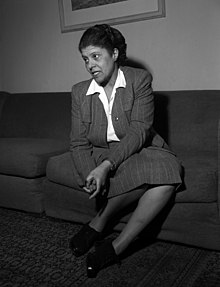Eslanda Goode Robeson
Eslanda Goode Robeson (1896 - 1965), born December 15, 1896, was an American author, anthropologist and activist. She is best known as a critic of the United State’s racial laws, a supporter of African independence from colonial powers, and as the wife of Paul Robeson.[1] Eslanda Goode Robeson had a large impact on the Civil Rights Movement where she fought segregation and racism in the United States. She continued this work until her death in 1965.

Background & Education
changeEslanda Goode Robeson was born in 1896 in Washington, D.C. Her father was a clerk, and her mother was a beautician. Robeson attended the University of Illinois before transferring to Columbia University, where she earned a bachelor's degree in chemistry in 1923.[1]
In 1921 she married a law student named Paul Robeson, who would go on to become a very famous singer, actor, and political activist. Their son, Paul Jr., was born in 1927.[1]
The Robeson’s moved to London in 1928 for Paul Sr.’s career as a performer. While living in London, Robeson became interested in the history and culture of the African diaspora, and she eventually began her graduate studies in anthropology at the London School of Economics. She studied social anthropology and African cultures under the well-known anthropologist, Bronislaw Malinowski.[1]
Career
changeRobeson started her career as the first African American hired at New York City's Presbyterian Hospital in the surgical pathology department[2] She then left this career after marrying her husband, Paul.
Eslanda Goode Robeson was also in filmmaking, mostly as an actress. She acted in the silent films Borderline (1930) and Big Fella (1937).
Publications
changeOver the course of her life, Robeson wrote three books: Paul Robeson, Negro (1930), a biography of her husband, African Journey (1945), an ethnographic work on sub-Saharan Africa in the 1930’s, and American Argument (1949), a wide-ranging conversation between herself and the author, Pearl S. Buck.[3]
African Journey (1945)
changeRobeson’s most well known book, and most significant contribution to the field of anthropology, was African Journey, published in 1945.[1]
African Journey is the account of a trip she took to sub-Saharan Africa in 1936 with her then nine-year-old son.[1] Robeson wrote of her experiences with a wide variety of people in southern and eastern Africa; miners, farmers, tribal people, herdswomen, doctors, white colonial officials.[3] She also detailed the roles of women and gender in each culture.[3]
The book is not written in a traditional academic style, but in an easy-to-read way that would give it a wide audience outside of academia. Her goal in writing the book was to challenge the negative views of Africa and Africans that were widely held in the United States by both White and Black Americans, partly because of how they were portrayed in the media.[1]
During her trip, Robeson spent much of her time in countries which were European colonies. It was important for her to show, through her writing, the negative impact that colonial rule was having on the communities she visited.[4] Throughout African Journey, she connects the daily lives and struggles of Black Africans with those of Black Americans.[1]
Robeson wanted to show her readers that African people were not “primitive,” but as much a part of the modern world as they were and held jobs that would be familiar to anyone in the United States (train engineer, teacher, hotel manager, bank clerk).[1][4] One way she did this was with photography. African Journey includes over 60 photographs (taken by Robeson) showing everyday scenes of Africans working, going to school, and spending time with family.[1] She carefully selected photographs that would look familiar to her Western audience.
African Journey was bound to be noticed because of her husband’s fame, but it was well received by critics across racial lines[3] and was selected by the American Library Association as one of the fifty outstanding books of 1945.[1]
The publication became famous to the public and was one of the first books to show a positive view of African people. Because of her publication many African Americans were able to relate to individuals in Africa.[3]
References
change- ↑ 1.00 1.01 1.02 1.03 1.04 1.05 1.06 1.07 1.08 1.09 1.10 Mahon, Maureen (2006). "Eslanda Goode Robeson's African Journey: The Politics of Identification and Representation in the African Diaspora". Souls. 8 (3): 101–118. doi:10.1080/10999940600882830. S2CID 144113254 – via Taylor & Francis Online.
- ↑ Morgan, Kyna (2013). "Eslanda Robeson". Women Film Pioneers Project. Archived from the original on 2022-12-15. Retrieved 2022-12-15.
{{cite web}}: CS1 maint: bot: original URL status unknown (link) - ↑ 3.0 3.1 3.2 3.3 3.4 Shaffer, Robert (Winter 1999). "Out of the Shadows: The Political Writings of Eslanda Goode Robeson". Pennsylvania History. 66 – via PennState University Libraries.
- ↑ 4.0 4.1 Robeson, Eslanda Goode. What Do the People of Africa Want? By Mrs. Paul Robeson. New York (State): Council on African Affairs, 1945.